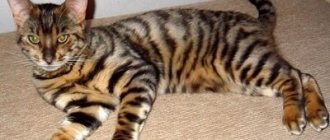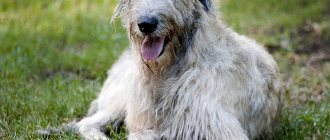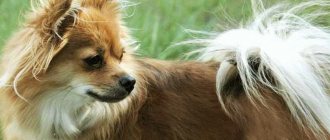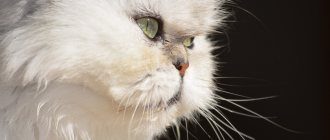Sheep rabbits today are raised on farms and private farms for meat and fur, but some individuals are lucky enough to become pets. It is not by chance that they are chosen as a friend, since the nature of the animals is very friendly, and their appearance, due to their short legs and long drooping ears, is very funny and somewhat toy-like. Initially, the breed was considered not industrial, but decorative. Livestock breeders who breed rabbits on their farms for personal use or sale note that these animals are the optimal combination of productivity relative to the cost of effort and money.
Ram breed data
Ram rabbits got their interesting name due to the shape of their muzzle. The wide forehead, drooping ears and hooked nose are a bit reminiscent of a ram's head. Animals quickly gain weight, so they are classified as a subspecies of meat rabbits.
Main characteristics:
- the average weight of rodents is approximately 4 to 10 kg;
- body length about 70-73 cm;
- massive head with plump cheeks;
- The coat color is varied: brown, black, gray, blue.
This breed of rabbit is probably one of the calmest and most peaceful. Their hearing aid is designed in such a way that the animals do not perceive surrounding sounds (the ear apparatus is closed by a certain anatomical membrane). Despite the fact that sheep breed rabbits are a meat breed and are popular among farmers, they are loved to be bred as pets. They respond to their name and are trainable.
What do you need to know about maintenance and care?
Due to their exterior features, namely long ears, the animals will need a larger cage than other rabbits. An important component of the content is the presence of walking space. Sheep are heat-loving species, so winter housing has separate heating requirements.
The presence of long ears requires knowledge of special subtleties of care. It is important to maintain hygiene and clean your pets' ears in a timely manner.
Due to their large size, animals exhibit some manifestations of laziness; rabbits are not very willing to mate. The most favorable time for crossing is six months of age. When the blood flows from breeds with erect ears, it results in young animals with slightly protruding ears, but later the sign of lop ears is lost.
Animals need to be fed based on their age, and best of all, at the same hours, three times a day. Rabbits can be given nettles, plantain leaves, dandelions; most often, all these components are already present in the green mass. Cereals are an essential part of the diet. The presence of drinking bowls in each cage is especially necessary for suckling females. With the onset of winter, decorative rabbits are given fine hay, which includes various crops.
The cages consist of several bars with plastic trays more than 10 cm deep. With this content, the animals will have the opportunity to dig holes. Some cages contain small houses - shelters. Large wood shavings are used as bedding, which will absorb urine well and will not irritate the respiratory system, unlike peat. A shaded place is suitable for cages; it is strictly forbidden to place them in close proximity to heating appliances.
We recommend an article on our website about other breeds of rabbits. It will be interesting
Origin and appearance
The breed was bred back in 1850. To obtain the breed, the Belgian giant was crossed with the English fold. In Germany, the animals have gained the greatest popularity, which is why the country is considered its historical homeland. The ram decorative rabbit is the sickest among other breeds.
There are many varieties of this breed. They are found in England, Germany and France. In every country, breeders worked to improve the species. Animals are resistant to various climatic conditions. They were brought to Russia several decades ago, and since then they have become popular among farmers. Their lifespan is about 10-12 years.
Hanging long ears became a sign of mutation. Today this feature of animals gives them enormous popularity. When closed on the head, the ears form a crown. It is interesting to know that some ram rabbits have ears that are up to 70 cm long and 15 cm wide. For convenience, the ears are sometimes fixed on the head with special clips.
Appearance:
- massive head and wide chest;
- soft and smooth fur;
- nose with a hump;
- chubby cheeks;
- long ears forming a crown on the head;
- tail adjacent to the body.
Keeping rabbits does not cause any problems. Every adult will like a beautiful and affectionate rabbit, and will delight a child.
Care and hygiene
As mentioned above, rabbits of this breed do not need any special hygiene. It is important to follow basic rules that will allow your animal to live a healthy and carefree life.
Hygiene recommendations:
- Inspect the ears. When they become dirty, you need to clean them with a regular ear stick or cotton wool wrapped around a match. The process must be carried out carefully and with periodic regularity. To avoid damaging the eardrum, do not push the cotton pad deeply.
- Brush the fur. It is recommended to do this procedure regularly, as tangles form on the fur, which cause diaper rash and itchy skin.
- Keep your claws trimmed. Rabbits need to have their claws trimmed once every 4-5 months.
- Get vaccinated against myxomatosis.
Important! It is not recommended to bathe lop-eared rabbits (only in emergency cases, for example, after diarrhea).
Veterinarians say that during washing, protective lubricant is washed off the skin, and also after water procedures, eared cats can easily catch a cold. It is enough to wipe the dirty fur with a damp cloth, and the animals lick off the remaining dirt on their own.
Diet features
Rabbits of this breed, depending on their age, need 2-3 meals a day. It is recommended to give food at the same time. A new product should be introduced gradually, starting with a small portion.
The composition of the feed is recommended as follows:
- hay and twigs of bushes and trees (hay should always be in the rodent cage);
- vegetables (in the form of treats, 2-3 times a week): carrots, cabbage, zucchini;
- feed (twice a day, 1 tablespoon or 40-80 g per kilogram of weight).
- grain crops (oats, wheat).
- fruits (in the form of treats, 1-2 times a week): pears, banana, apple (prevention of constipation).
Don't forget about clean water, which needs to be updated daily. A sheep rabbit needs minerals, so you can put pieces of chalk and salt stones in the animal’s cage.
Features of care
Lop-eared rabbits are rodents, so they are always on the lookout for something to chew. Therefore, everything that an animal can chew must be removed (especially wiring from equipment). It is recommended to let the animal out to walk around the house for 2-4 hours; the rest of the time the pet can stay in its cage. For a comfortable stay, he needs to create all the necessary conditions.
Key points in caring for an animal:
- The cage should be 5-6 times larger than the rabbit.
- There should be a small house or a large overturned bowl inside where the animal can hide.
- The cat's house should not be in a draft or direct sunlight. But there should be good ventilation and lighting around it.
- Rabbits of this breed are very clean, so keep track of where the animal empties and place a tray there. They easily learn to use the tray, which should be cleaned every day.
- It is better to secure the sippy cup and food bowl in the cage so that the animal does not overturn the containers.
Fold-eared rams love attention, so you need to play with them periodically. For them, you can either buy or make various toys from wood, cardboard or paper yourself. These could be balls, mazes, unnecessary old books that the pet could tear. If a fluffy dog is not given attention for a long time, he may show aggression in order to attract attention to himself.
Features of breeding sheep breed rabbits
Breeding this breed of rabbit is not difficult. Animals are fully mature for breeding at 6 months. Unfortunately, ram rabbits are not very fertile. The maximum litter for one birth is 4-7 babies.
For proper reproduction, rabbits begin to be bred from their very birth, when the rabbits are separated by gender and health status. It is believed that when a female reaches three years of age, she is no longer allowed to breed, as childbirth could lead to her death.
Raising fold sheep is no different from raising other breeds of rabbits. For mating, healthy individuals are selected, which are fed only high-quality and healthy food before breeding.
Breeding secrets
Experienced rabbit breeders know the secrets of breeding sheep and rabbits, for example:
- Reproduction is allowed only after individuals reach maturity. Females are allowed to mate from 8-9 months of age, males - from 5-6 months.
- You cannot mix individuals of different breeds. The offspring after such experiments are born with defects in appearance.
- Only the most ideal individuals are suitable for mating.
- Obese animals should not be allowed to mate. Fold sheep whose weight does not exceed 5 kg can become parents.
- The process is organized on the territory of the male. A female rabbit is placed in his pen.
- Females are allowed to mate selectively. Only young animals aged from 9 months to 3 years can give birth to healthy offspring. After the age of three, females are prohibited from giving birth. Childbirth can cause the death of the animal and its offspring.
French ram
The subspecies first appeared in England in the 19th century, through the hybridization of the lop-eared rabbit and the German giant. As a result of this crossing, individuals were obtained weighing up to 8 kg and with ears up to 50 cm long. The subspecies is characterized by a rapid increase in live weight. Rabbits of the French Ram breed gained their popularity very quickly.
Main characteristics of rabbits of the French Ram subspecies:
- massive body;
- plump cheeks;
- broad forehead;
- small muzzle;
- varied coat color (gray, spotted, white, blue);
- big head.
The main feature of this breed is the characteristic crown in the middle of the head. Thanks to its friendly nature, the French ram can become an excellent friend and beloved pet.
History of the breed
Most modern breeds have among their ancestors domestic rabbits from Western European countries, as well as Mediterranean ones. Rams are a different story. The breed group, on the basis of which animals were subsequently bred, was obtained in Great Britain in the 19th century. Initially, what has now become a characteristic feature of rams was considered a mutation, namely drooping ears. Breeders from England decided to consolidate this unusual trait, and this is how a separate breed turned out.
Thanks to their main feature, ears, it has become very popular to breed sheep almost all over the world. For some species, the usual length of the ears is over 70 cm, with a width of 10-17 cm.
Some breeders use special ear clips to attach the ears to the heads of rabbits to make the animals comfortable. In order for animals to gain more weight, they undergo castration.
Dwarf ram
Rabbits of the dwarf ram breed have appeared recently, they are the smallest. The dwarf ram has become a favorite ornamental animal. The dwarf rabbit of the ram breed is small in size and light in weight - only 1.2-1.9 kg. The breed has long ears, short legs, a wide build and short fur.
The breed first appeared in the Netherlands and quickly became popular here. The dwarf rabbit has erect ears, which droop over time, the length of which in adults is 25 cm. The color can be very diverse.
Kinds
Today, breeders have bred various types of rams. Depending on the purpose for which the animal is purchased, one type or another is selected.
English
The rabbit breed is the rarest, since due to the gigantic length of its ears they require large areas. Without this, the pet will begin to step on its ears, which can lead to dangerous injuries. The hind legs of animals are much longer than the front ones, and therefore, when the pet sits, the effect is created that the rabbit's croup is much higher than the front of the body. The animals' fur is short and very dense. The colors are very varied.
Fold rabbits of the English ram breed
A beginner should not have such a rabbit, as it requires a lot of attention and competent care. Without this, the animal quickly begins to run wild and becomes timid, despite the fact that with proper care it is very sociable and friendly.
French
Rabbits of the French Ram subspecies
French Ram rabbits are large, up to 8 kg, which makes them in demand commercially. The rate of live weight gain is high, so breeding them for meat is especially profitable. Due to their large size, animals must be kept in spacious cages to allow them full movement.
Corduroy
Female corduroy ram breed
A dwarf variety of ram rabbits, bred in the 2000s. The exact standard of the species has not yet been established, as the breed continues to be refined and improved. The weight of the animals ranges from 2 to 3 kg.
Dutch
Rabbit - Dutch Ram
The smallest rabbits of the Ram breed, weighing only 1.3 -1.8 kg. In Western countries, the species is very popular and is actively kept as a pet. The character of the pets is quiet, friendly and inquisitive. Animals have different colors.
Dwarf
A cute representative of the dwarf ram.
Small animals weighing up to 2 kg with a pleasant character. They are very affectionate to their owner. When purchasing, it is not recommended to choose rabbits heavier than 2 kg and lighter than 1 kg. Raising animals with the right approach is not difficult.
Meissen
Meissen rabbit ram
The weight of the animals is from 3 to 5 kg. Their fur is dense and shiny. The ears are thick and densely pubescent, which is why a crown is created on the head. The breed is rare and is under special protection in Germany to prevent its extinction. Its breeding is now aimed at restoring the species.











